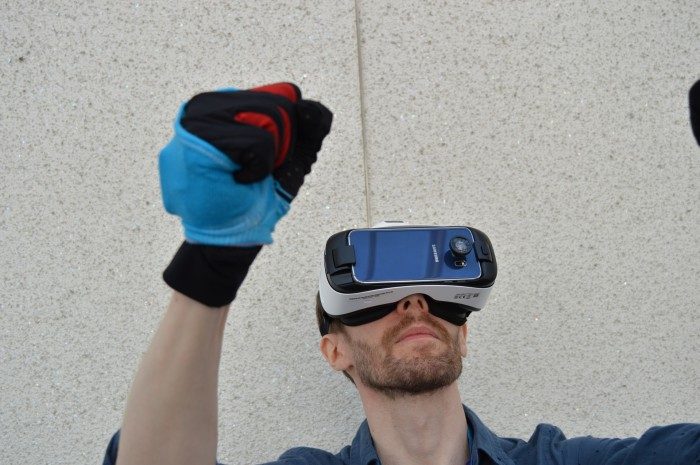Manus, the minds behind the eponymous VR data glove and Open Source Virtual Reality (OSVR) partners, have revealed to us that they are well on their way integrating OSVR equipment for their wireless VR gloves
Far from giving up on the realization of a VR data glove, lead designer Stijn Stumpel and PR officer Bob Vlemmix sat down with me to try out the latest prototype of the gloves, and explain some of the benefits of their recent partnership with the OSVR.
The Netherlands based startup has been plugging away at design elements of Manus, such as material, unit weight and compactness ever since falling short of their summer of 2014 Kickstarter campaign funding goal. A far cry from their early conceptual unit, which last year was shown to us in its prototype-y glory replete with exposed wires and plastic Tupperware carrying case, Manus showed us their newest prototype with improved hygenic sports fabric made from polyester lycra.
See Also: Video Preview: Manus Machina’s Wireless VR Glove Looks Promising, Headed to E3 2015
Running on a the S6 edition of Gear VR, I calibrated the gloves by looking through a passthrough camera using fish eye lens for optimal field of view, a necessity for positionally tracking the blue and green ‘tracking mittens’: essentially little elastic cuffs that went over the entire unit. Because the gloves transmit via Bluetooth, the entire experience was wireless.
I found the experience to be promising, and see how Manus will greatly benefit from increased computing power provided by the tethered OSVR platform with cameras sourced from Razer. The demo itself, which featured ‘finger guns’ that shot when you extended your index finger, was an interesting sight to see in our improvised interview corner carved from a few idle lounge chairs between the business center at Gamescom—in a way emblematic of the company that made it; ready to try anything and everything, mobile or tethered to see where wireless data gloves fit into the consumer market. Manus is scrappy, and approaching the glove with an “anything that works” attitude that we can’t wait to see more from. That said, the actual finger tracking was good enough visually, and at what I would call low latency.
See Also: CES 2015: Razer Announces $199 ‘Hacker Dev Kit’ VR Headset as Part of OSVR Initiative
Vlemmix elucidates more on their choice to go with OSVR:
“We decided that the best course of action for our product is not to develop our own tracking solution. We want to create a user friendly solution that does not require the user to set up additional tracking cameras or base stations. As such, we want to support the tracking solution that each individual HMD provides. With Oculus that would mean their constellation tracking, with HTC Vive the Valve Lighthouse. We recently got OSVR on board and we are one of the first companies that can announce that we will integrate their IR tracking in our glove design. We received their HDK and our engineers are working hard to get OSVR support integrated as soon as possible…”









